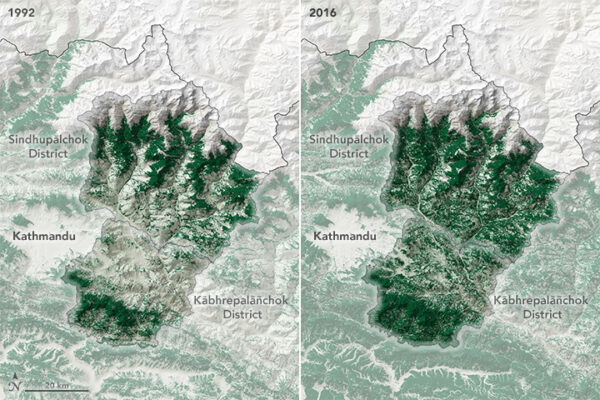A new modelling study by The Lancet finds that increasing tree cover by up to 30 % can help reduce temperatures, on an average of, 0.4 degrees Celsius and prevent heat-related deaths
Ishfaq Tantry
India, Feb 1
A new modelling study by The Lancet has suggested that planting more trees could lower the human deaths attributed to summer temperatures and heat waves by a third.
The study modelled on 93 European cities has also found that increasing tree cover up to 30% can help lower the temperature of urban environments by an average of 0.4 degrees Celsius and prevent heat-related deaths.
Of the 6,700 premature deaths attributed to higher temperatures in cities during 2015, one-third of these (2,644) could have been prevented by increasing urban tree cover up to 30%, the study has suggested.
The authors of the study have stressed that these findings highlight the need for more sustainable and climate-resilient strategies to be integrated into local policy decisions to aid climate change adaptation and improve population health.
“One-third of premature deaths attributable to higher temperatures in European cities during summer 2015 could have been prevented by increasing urban tree cover to 30%”, reveals a modelling study published in The Lancet.
The study also found that tree cover reduced urban temperatures by an average of 0.4 degrees Celsius during the summer.
“We already know that high temperatures in urban environments are associated with negative health outcomes, such as cardiorespiratory failure, hospital admission, and premature death. This study is the largest of its kind, and the first to specifically look at premature mortality caused by higher temperatures in cities and the number of deaths that could be prevented by increasing tree cover,” says lead author, Tamara Lungman, Barcelona Institute for Global Health.
“Our ultimate goal is to inform local policy and decision-makers about the benefits of strategically integrating green infrastructure into urban planning in order to promote more sustainable, resilient and healthy urban environments and contribute to climate change adaptation and mitigation. This is becoming increasingly urgent as Europe experiences more extreme temperature fluctuations caused by climate change; despite cold conditions currently causing more deaths in Europe, predictions based on current emissions reveal that heat-related illness and death will present a bigger burden to our health services over the next decade.”
Urban environments record higher temperatures than the surrounding countryside generally referred to as “urban heat islands”.This temperature difference is caused by human modification of landscapes, such as the removal of vegetation, the presence of asphalt and use of building materials that absorb and trap heat.
Urban tree plantation helps to reduce temperatures:
As emissions continue to exacerbate climate change and global heating, increased temperatures in cities are predicted to become more intense, resulting in an increasingly urgent need for cities to adapt to improve health outcomes.
The results of this study support the idea that urban trees provide substantial public health and environmental benefits, however, the authors acknowledge that increasing tree coverage should be combined with other interventions to maximise urban temperature reduction (for example, changing ground surface materials to reduce night-time temperatures such as replacing asphalt with trees). Meeting the target of 30% tree coverage can be very challenging for some cities due to urban design, with city average tree cover in Europe currently at 14.9%.
How the modelling was done?
The researchers estimated mortality rates of residents over 20 years old in 93 European cities between June and August 2015, accounting for 57 million inhabitants in total.
Mortality data from this period was analysed with daily average city temperatures in two modelling scenarios: the first comparing the city temperature without urban heat islands to city temperature with urban heat islands, and the second simulating the temperature reduction as a consequence of increasing the tree cover to 30%. Exposure-response functions were used to estimate the number of deaths attributable to urban heat as well as the number of deaths that could be prevented by increasing the tree cover.
The population-weighted city average daily temperature difference between cities and the countryside from June – August 2015 was 1.5 degrees warmer than the surrounding countryside, with the maximum temperature difference measured at 4.1 degrees hotter in Cluj-Napoca, Romania.
Across all cities, 75% of the total population lived in areas with an average summer city temperature difference greater than one degree, and 20% with an average summer temperature difference greater than two degrees, compared to the surrounding countryside.
In total, 6,700 premature deaths could be attributed to hotter urban temperatures during the summer months, accounting for 4.3% of summer mortality and 1.8% of year-round mortality. One in three of these deaths (2,644 total) could have been prevented by increasing tree cover up to 30%, and therefore reducing temperatures. This corresponds to 39.5% of all deaths attributable to hotter urban temperatures, 1.8% of all summer deaths, and 0.4% of year-round deaths.
There was large variability in temperature-related mortality rates between cities, from no premature deaths attributable to hotter urban temperatures in Goteborg, Sweden, to 32 premature deaths per 100,000 people in Cluj-Napoca, Romania. Overall, cities with the highest temperature mortality rates were in Southern and Eastern Europe where the highest temperatures were reached, with these cities benefitting the most from an increase in tree coverage.
“Our results suggest large impacts on mortality due to hotter temperatures in cities, and that these impacts could be partially reduced by increasing the tree coverage to help cool urban environments. We encourage city planners and decision-makers to incorporate the urban green infrastructure adapted to each local setting whilst combining with other interventions to maximise the health benefits while promoting more sustainable and resilient cities, especially as we already know that green spaces can have additional health benefits such as reducing cardiovascular disease, dementia and poor mental health, improving cognitive functioning of children and the elderly, and improving the health of babies,” says study co-author Mark Nieuwenhuijsen, Director of Urban Planning, Environment and Health at the Barcelona Institute for Global Health.
Limitations
The authors acknowledge some limitations of the study. The study could not be conducted for a more recent year than 2015, due to the unavailability of population data. In addition, a US dataset was used for building the cooling model in the study as opposed to a European dataset. Finally, the study focused on the health impacts of high temperatures but did not look at cold temperature.




